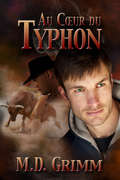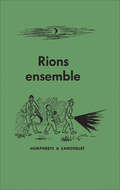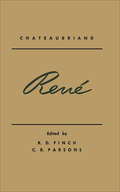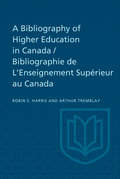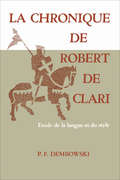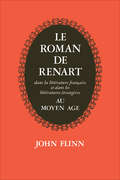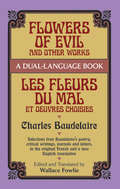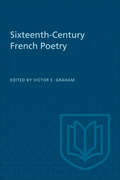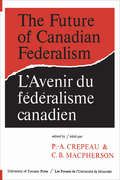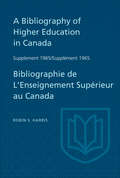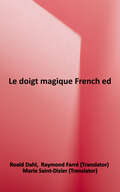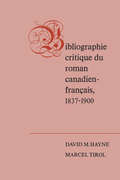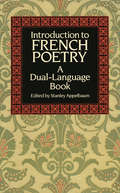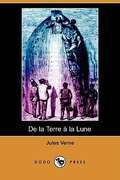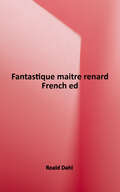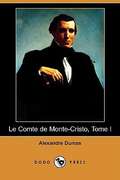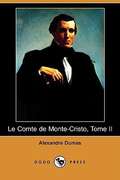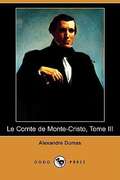- Table View
- List View
Au cœur du typhon (La saga des métamorphes #2)
by Iriam Shostakovich M. D. GrimmLa saga des métamorphes, tome 2Ryan et Caleb sont devenus les meilleurs amis au monde alors que Caleb guidait et accompagnait Ryan sur les pas d'une existence humaine. Ryan est un métamorphe né taureau sous le nom de Typhon, et recueilli par la mère de Caleb afin de le protéger. Caleb ne tarde pas à se montrer protecteur lui aussi. Au fil du temps passé ensemble, la teneur des sentiments qui lient l'humain au métamorphe taurin évolue et l'intensité ne fait que s'approfondir. Mais alors qu'ils décident enfin de donner une chance à leur relation de couple, Ryan est enlevé. Caleb est donc forcé de contacter l'Agence - une organisation qui veille sur les animorphes - s'il ne veut pas que leur nouvelle vie ne se termine avant même d'avoir pu réellement commencer.
Rions ensemble
by Harold Humphreys Michel SanouilletThe twenty-five crisp and amusing short stories in this collection prove that elementary readings in French can also be entertaining. Some are original anecdotes and others adaptations of traditional French of French-Canadian stories, some are from anonymous sources, and some by acknowledged masters such as LaFontaine. All are distinguished by the classic literary virtue of the French—precision, economy, and the traditional Gallic twist. A delightful series of line drawings by Antje Lingner aptly reflects the spirit of the book. This collection is designed for reading in Grades XI and XII, and for introductory courses at the University or Extension course level. To encourage a quick response and facility in reading, the stories emphasize the idiomatic and rely heavily on dialogue, avoiding as much as possible an over-literary syntax. The text employs elementary vocabulary and constructions throughout and is representative in all respects of the spoken language today. The emphasis on conversational organization in the stories will be immediately apparent, and it is this feature that should be exploited in the classroom and other group situations. On a series of four long-playing records the entire text has been transcribed for use in oral and phonetics classes. The readings are given slowly but naturally and with a relish which catches the drama and humour of the material. The combination of text and recordings offers a most valuable method of acquiring aural familiarity with spoken French. The stories are supplemented with vocabulary, notes and exercises. For each story there is supplied a series of questions that lend themselves to oral answers and discussion; in addition there is a short exercise reviewing grammatical forms, with special emphasis on the verb, as well as a brief passage for prose translation into French.
René
by C. R. Parsons François-René de Chateaubriand R. D. FinchIf the writings of Chateaubriand, one above all is both most representative of its author and most significant for reader and student alike. René, a milestone of literature, presents the first genuine and complete picture of that state of spiritual frustration and moral isolation known as le mal du siècle, its causes, symptoms, ravages, and cure.Chateaubriand, a prodigious artist with an incomparable style, enjoys the further distinction of having fused in his work the end of one epoch and the beginning of another. It is sometimes forgotten that these epochs are not only French but also European in scope, and their reverberations as expressed by Chateaubriand have affected almost every subsequent writer of importance up to the present. Chateaubriand is often called the father of romanticism. It may be claimed with equal reason that he is the grandfather of the neo-romanticism of our time.This edition of René contains, as well as a full introduction, notes covering the allusions to place names, events, and personages, and a complete vocabulary.
A Bibliography of Higher Education in Canada / Bibliographie de L'Enseignement Supérieur au Canada
by Robin Harris Arthur TremblayThis bibliography is the first of a series of studies about higher education in Canada sponsored by the committee on the History of Higher Education in Canada established by the National Conference of Canadian Universities. Among its nearly 4,000 entries are included the books, pamphlets, theses, dissertations, and articles in journals and magazines which supply the context and commentary on the history of Canadian higher education. Part I of the Bibliography provides the context; our universities do not exist in a vacuum—they are part of the economic, political, religious and social life of the community. Part I, therefore, includes a section on Canadian Culture, listing histories of Canada and its provinces, of its religious and social institutions, of its art, its economy, racial groups, relations with other countries. In order to study higher education in relation to other levels of education, another section lists works concerned with educational developments and problems at all levels. Part II lists the works bearing directly on higher education in Canada, and includes sections on History and Organization, Curriculum and Teaching, The Professor, The Student. Entries are arranged in chronological order in all sections in order to present the progressive development of each topic, and a full Index enables easy reference by author. No distinction has been drawn between English- and French-language publications: Chemistry and Chimie are one subject. The relative proportion of English and French entries in a section is often significant as indicating differences in the frequency and importance of particular fields of study in our colleges.
La Chronique de Robert de Clari: Etude de la langue et du style
by Peter DembowskiRobert de Clari (died c. 1220), a member of the Lesser Picard nobility from the vicinity of Amiens, left a chronicle of the Fourth Crusade in which he took part. This is an important work in the study of the development of the French language, because it is one of the first original prose texts in French, neither translated from Latin nor resulting from "prosification" of verse-compositions. Professor Dembrowski's study is a close analysis of language and style, revealing Robert de Clari's ability in the narration of short anecdotes and in the reproduction of dialogue. University of Toronto Romance Series, Number 6.
Le Roman de Renart: Dans la littérature française et dans les littérature étrangères au moyen âge (University of Toronto Romance Series #4)
by John FlinnThe Roman de Renart was for long little known, even in France, in its original mediaeval version, but the reputation of the wily fox was widespread, in large measure because of his fame in the Middle Ages. This fame had spread to much of the rest of Western Europe and the stories of Renart had inspired many different literary works in many countries; they were among the earlier published works in Belgium, Holland, Germany, and England. A copious iconography - mediaeval wall-paintings, misereres, architectural carvings, manuscript illustrations, and, later, book illustrations - maintained the frame of the wily fox. Renart, originally a comic but also satirical personage, finally became one of the most popular personifications of the devil in literature and in art.<P><P> This book will interest the specialist in many fields, treating as it does a subject that had ramifications not only in French literature, but also in German, Italian, Flemish and Dutch, English, and mediaeval Latin literature. Interest in the Roman de Renart has increased notably of late, and the iconography of Renart continues to attract attention. For students of English literature the subject of Renart is an important one, first because of the close relationship of mediaeval French and English literature, and also because of Chaucer's charming story of the Nun's Priest Tale, which was largely inspired by the oldest French branch of Renart.
Flowers of Evil and Other Works: A Dual-Language Book (Dover Dual Language French Ser.)
by Charles BaudelaireWhen Flowers of Evil was first published in 1857, the book almost immediately became the subject of an obscenity trial, and for several generations afterward its themes of eroticism, lesbianism, revolt and decay earned the author a reputation for depravity and morbidity. It was not until 1949 that the French courts removed the ban originally imposed on Baudelaire's masterpiece.Today, Flowers of Evil is regarded as the poet's greatest work and perhaps the most influential book of French poetry ever written. In assessing Baudelaire's importance in literature, Wallace Fowlie, distinguished scholar, critic and Baudelaire specialist, describes him as "the poet and thinker of our age, of what we like to call modernity."This handsome dual-language edition combines Flowers of Evil with a selection of the poet's other significant compositions, including prose poems from Spleen of Paris, a poignant collection reflecting Baudelaire's pessimism towards the teeming city and his compassion for its less successful inhabitants. Readers will also find critical essays on art, music and literature, including a discussion of Edgar Allan Poe's poetry; and Baudelaire's personal letters to his mother and female acquaintances. Edited and translated by Professor Fowlie, this authoritative edition contains excellent line-by-line English translations with the original French text on the facing pages.Students of French language and literature as well as poetry lovers with some knowledge of French will welcome this volume by one of the greatest European poets of the 19th century.
Sixteenth-Century French Poetry
by Victor E GrahamIn this anthology an effort has been made to include representative selections from the most significant sixteenth-century French poets. With the exception if a few longer works (mainly those of Ronsard, Du Bartas, and D'Aubigné), poems are given complete. In addition, the original spelling and punctuation have been retained as far as possible, except for the usual editorial modifications (differentiation of u and v, i and j, the addition of accents à, où, replacement of & by et, and so on). The sixteenth century is a period of tremendous poetic activity. It is a period closer in spirit to us in many ways than the intervening centuries, particularly the seventeenth and the eighteenth. Its poetry is still being rediscovered and re-assessed in a way that is just as exciting as the period of foment during which it was written.
The Future of Canadian Federalism/L'Avenir du federalisme canadien
by C. B. Macpherson Paul-Andre CrepeauBy the beginning of 1964 public debate about the terms on which French and English culture could continue to co-exist within a single Canadian federal state had become intense. Many causes could be assigned for the intensity of the debate, but one of them evidently was the lack of clear formulation of the problems. It was in these circumstances that the Association of Canadian Law Teachers and the Canadian Political Science Association used their annual meeting at Charlottetown in 1964 to get, on each of four aspects of the current problem of Canadian federalism, a vigorously reasoned statement, by a French-Canadian and an English-Canadian scholar, of the essentials of the problem as he saw it and then, by way of invited commentaries, to bring the ideas more fully into play. The four aspects were: competing concepts of federalism, economic problems peculiar to our federal state, legal and political attitudes towards the BNA Act, and institutional problems of a revision of the Act.
Supplement 1965 to A Bibliography of Higher Education in Canada / Supplément 1965 de Bibliographie de L'Enseighnement Supérieur au Canada
by Robin HarrisThis Supplement to the 1960 Bibliography by Harris and Tremblay adds some 3,500 entries to the approximately 4,000 listed in the first volume, providing a full list of articles, books, pamphlets, and theses bearing on all aspects of higher education in Canada for the period 1959-1963. The organization of the earlier volume has been maintained with slight modifications, and some new sections have been added, including one devoted to institutions which, although they are post-secondary, do not grant degrees; and one which includes plays and novels set wholly or in part in actual or fictitious Canadian universities. (Studies in Higher Education in Canada, No. 3)
Le Doigt Magique
by Roald DahlEvery Saturday, the Cassards, father and son, have fun duck hunting. But one day, their little neighbor, furious at this massacre, points her magic finger at them. Becoming a bird is a tough test for a hunter. Enough to make you give up hunting for good? A story full of humor for all those who dream of punishing the bad guys with a wave of a magic wand.
Bibliographie critique du roman canadien-francaise, 1837-1900
by David Hayne Marcel TirolCette bibliographie constitue la liste la plus complete jusqu'a ce jour des romans canadiens-francais publies avant 1900. Les compilateurs presentent une description exacte et detaillee de chaque edition publiee en volume separe, avec indication des bibliotheques ou un exemplaire de l'edition est conserve. La description est suivie d'une liste des etudes et articles qui ont ete consacres au roman en question, et dans la plupart des cas, de note bibliographiques ou biographiques. Un index des noms d'auteurs et des titres facilite la consultation des 1100 références que contient le volume. A l'heure actuelle les etudes de litterature canadienne-française sont en pleine expansion non seulement dans les universites canadiennes mais aussi dans de nombreux centres aux Etats-Unis. Par consequent cet ouvrage de reference, fruit de longues annees des recherches consacrees a l'histoire du roman canadien-francais, rendra de grands services aux professeurs et aux etudiants, aux bibliothecaires et bibliographes, aux libraires et aux amateurs du livre canadien.
Introduction to French Poetry: A Dual-Language Book (Dover Dual Language French)
by Stanley AppelbaumImmerse yourself in great poetic tradition -- works by Villon, Ronsard, Voltaire, Lamartine, Hugo, Mallarmé, Verlaine, Rimbaud, Apollinaire, Saint-John Perse, Eluard and many more. Full texts in French with literal English translation on facing pages. Critical, biographical information on each poet. Introduction. 31 black-and-white illustrations.
De la Terre à la Lune
by Jules VerneIt tells the story of the Baltimore Gun Club, a post-American Civil War society of weapons enthusiasts, and their attempts to build an enormous sky-facing Columbiad space gun and launch three people—the Gun Club's president, his Philadelphian armor-making rival, and a French poet—in a projectile with the goal of a moon landing.
Du côté de chez Swann
by Marcel ProustDu cote de chez Swann is the first volume of the novel by Marcel Proust , In Search of Lost Time . It consists of three parts, the titles are: Combray Swann in Love Country names: the name .
Fantastique Maitre Renard (French Edition)
by Roald DahlDid you hear that, Master Fox? We won't go home until you're hanging high! Farmer Boggis raises chickens. He is really huge and only eats juicy chicken cooked in a casserole dish. Farmer Bunce raises geese and ducks. He eats it with every meal, which gives him heartburn and a terrible temper. Farmer Bean grows apples, raises turkeys, and drinks gallons and gallons of strong cider. Master Fox is so clever that he sneaks into the valley every evening and collects provisions from the farms to feed Lady Fox and her four fox cubs. My farmers have hatched a plan to kill Master Fox. Bang ! Bang ! Bang ! They are sure to catch him but now Master Fox has a fantastic plan... Master Fox is so clever that he sneaks into the valley every evening and collects provisions from the farms to feed Lady Fox and her four fox cubs. But the farmers have hatched a plan to kill Master Fox... From 8 years old.
Le comte de Monte-Cristo, Tome I
by Alexandre DumasAlexandre Dumas (1802-1870) est un crivain franais. Il est n Villers-Cotterts (Aisne). Il reut une ducation plutt mediocre. Aprs des tudes ngliges, il travailla comme clerc chez un notaire et dbuta la rdaction de pices de th[tre avec son ami, le vicomte Adolphe Ribbing de Leuven. Ces premiers essais furent autant dchecs. En 1823, il entra au service du Duc dOrlans comme expditionnaire gr[ce sa calligraphie. Il lisait alors Shakespeare, Walter Scott, Goethe et Schiller qui furent les sources dinspiration principales de son th[tre. Il continua crire pour le th[tre et connut enfin le succs gr[ce la reprsentation en 1829 de Henri III et sa cour par la Comdie-Franaise. Ce succs continua pendant toute sa carrire littraire dans ses genres de prdilection: le drame, le roman historique et le feuilleton. Ses oeuvres comprennent: Les Trois Mousquetaires (1844), Le Comte de Monte-Cristo (1845-1846) et Le Vicomte de Bragelonne (1848).
Le comte de Monte-Cristo, Tome II
by Alexandre DumasAlexandre Dumas (1802-1870) est un crivain franais. Il est n Villers-Cotterts (Aisne). Il reut une ducation plutt mediocre. Aprs des tudes ngliges, il travailla comme clerc chez un notaire et dbuta la rdaction de pices de th[tre avec son ami, le vicomte Adolphe Ribbing de Leuven. Ces premiers essais furent autant dchecs. En 1823, il entra au service du Duc dOrlans comme expditionnaire gr[ce sa calligraphie. Il lisait alors Shakespeare, Walter Scott, Goethe et Schiller qui furent les sources dinspiration principales de son th[tre. Il continua crire pour le th[tre et connut enfin le succs gr[ce la reprsentation en 1829 de Henri III et sa cour par la Comdie-Franaise. Ce succs continua pendant toute sa carrire littraire dans ses genres de prdilection: le drame, le roman historique et le feuilleton. Ses oeuvres comprennent: Les Trois Mousquetaires (1844), Le Comte de Monte-Cristo (1845-1846) et Le Vicomte de Bragelonne (1848).
Le comte de Monte-Cristo, Tome III
by Alexandre DumasAlexandre Dumas (1802-1870) est un crivain franais. Il est n Villers-Cotterts (Aisne). Il reut une ducation plutt mediocre. Aprs des tudes ngliges, il travailla comme clerc chez un notaire et dbuta la rdaction de pices de th[tre avec son ami, le vicomte Adolphe Ribbing de Leuven. Ces premiers essais furent autant dchecs. En 1823, il entra au service du Duc dOrlans comme expditionnaire gr[ce sa calligraphie. Il lisait alors Shakespeare, Walter Scott, Goethe et Schiller qui furent les sources dinspiration principales de son th[tre. Il continua crire pour le th[tre et connut enfin le succs gr[ce la reprsentation en 1829 de Henri III et sa cour par la Comdie-Franaise. Ce succs continua pendant toute sa carrire littraire dans ses genres de prdilection: le drame, le roman historique et le feuilleton. Ses oeuvres comprennent: Les Trois Mousquetaires (1844), Le Comte de Monte-Cristo (1845-1846) et Le Vicomte de Bragelonne (1848).
